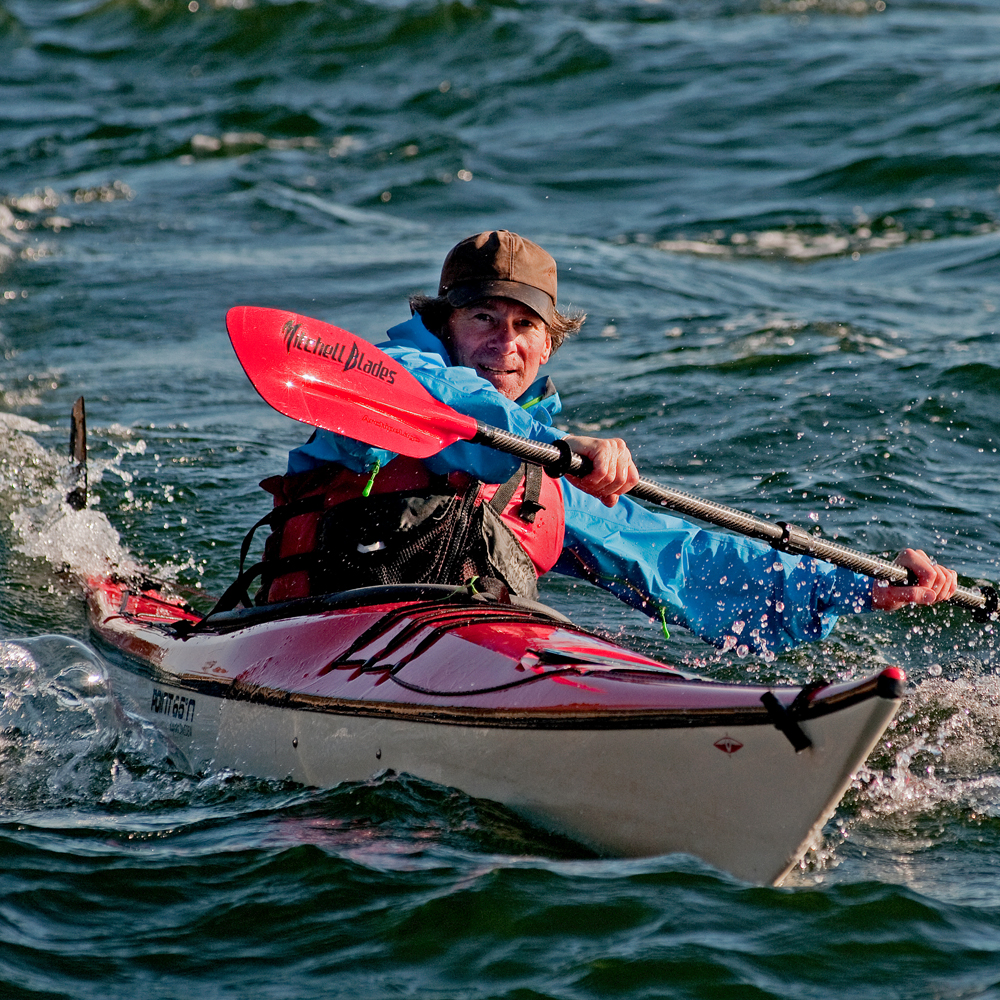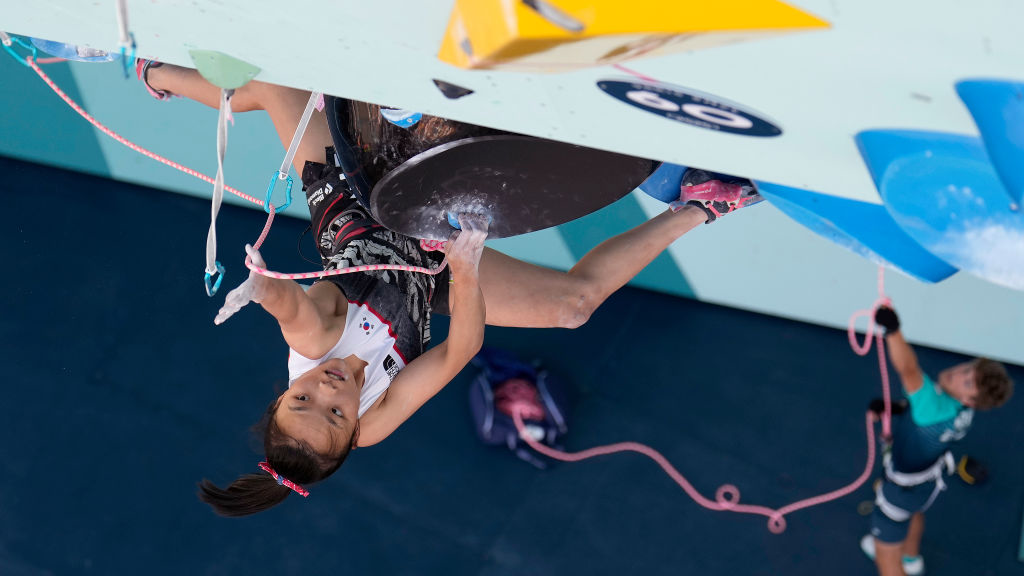The best hammocks: put your feet up and relax
Our roundup of the best hammocks will help you find the optimum hangout for all your future camping trips
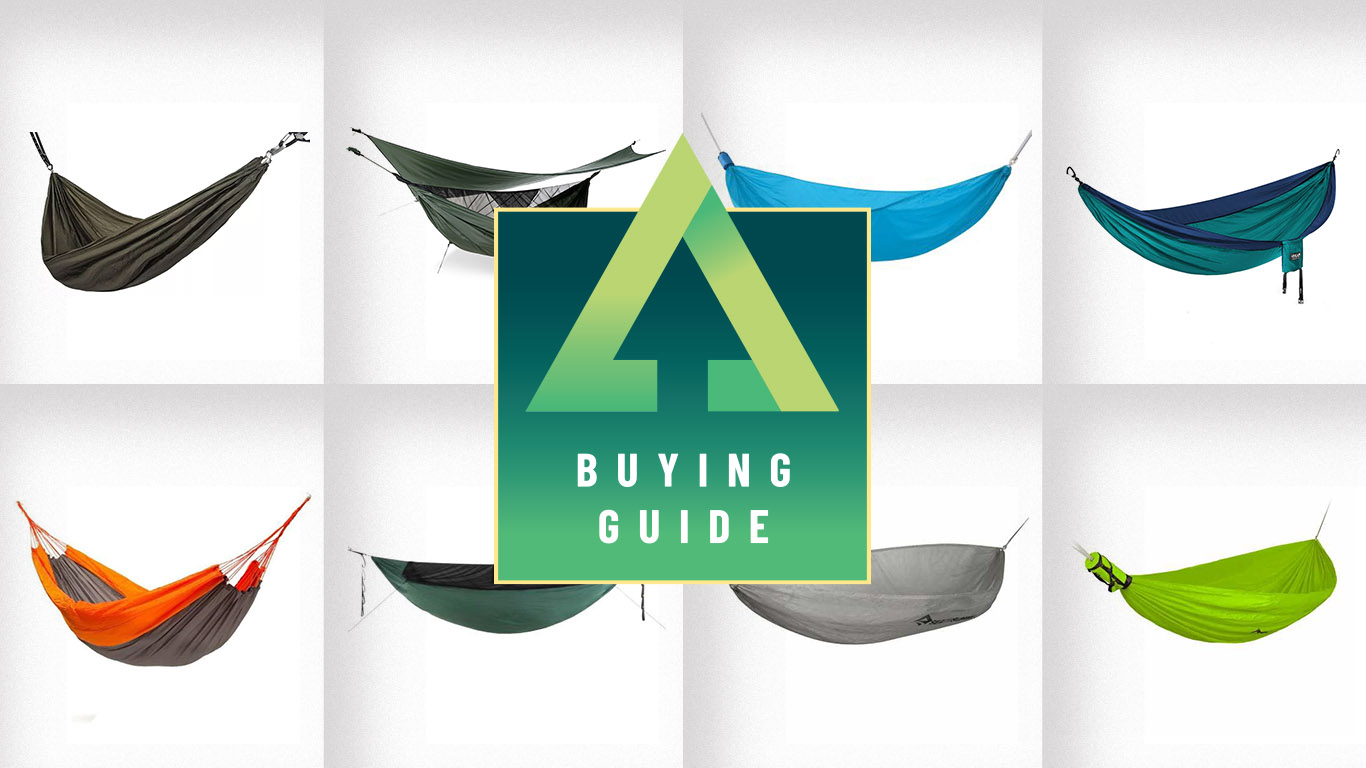
The best hammock is easy to assemble, comfortable, lightweight and allows you kick back during your camping or backpacking adventures. All you need to find is a couple of suitable anchors and you can set up anywhere, which is why having a 'mock gives you a glorious dose of freedom.
The best hammocks generally work in the same way. They comprise a robust fabric base attached to an easy to use suspension system that keeps everything off the deck. Hammocks have a long history and were first invented by natives of Central and South America, before Western sailors cottoned on to the idea and used them as sleeping platforms on ships.
Today, the humble hammock is a mainstay in the camping world, beloved by millions across the globe. Whether its for an afternoon siesta, a session with a good book, a hangout with friends or replacing a camping tent or bivvy as a sleeping system, a hammock has you covered.
Not covered literally, that is, as the best hammocks are usually open to the elements. However, many are bundled with add ons – such as tarp covers, mosquito nets and compatible blankets – or you can buy these separately. With a decent cover and one of the best sleeping bags, there's no reason not to use a hammock as your camping sleeping system this fall.
Hammocks for lightweight camping
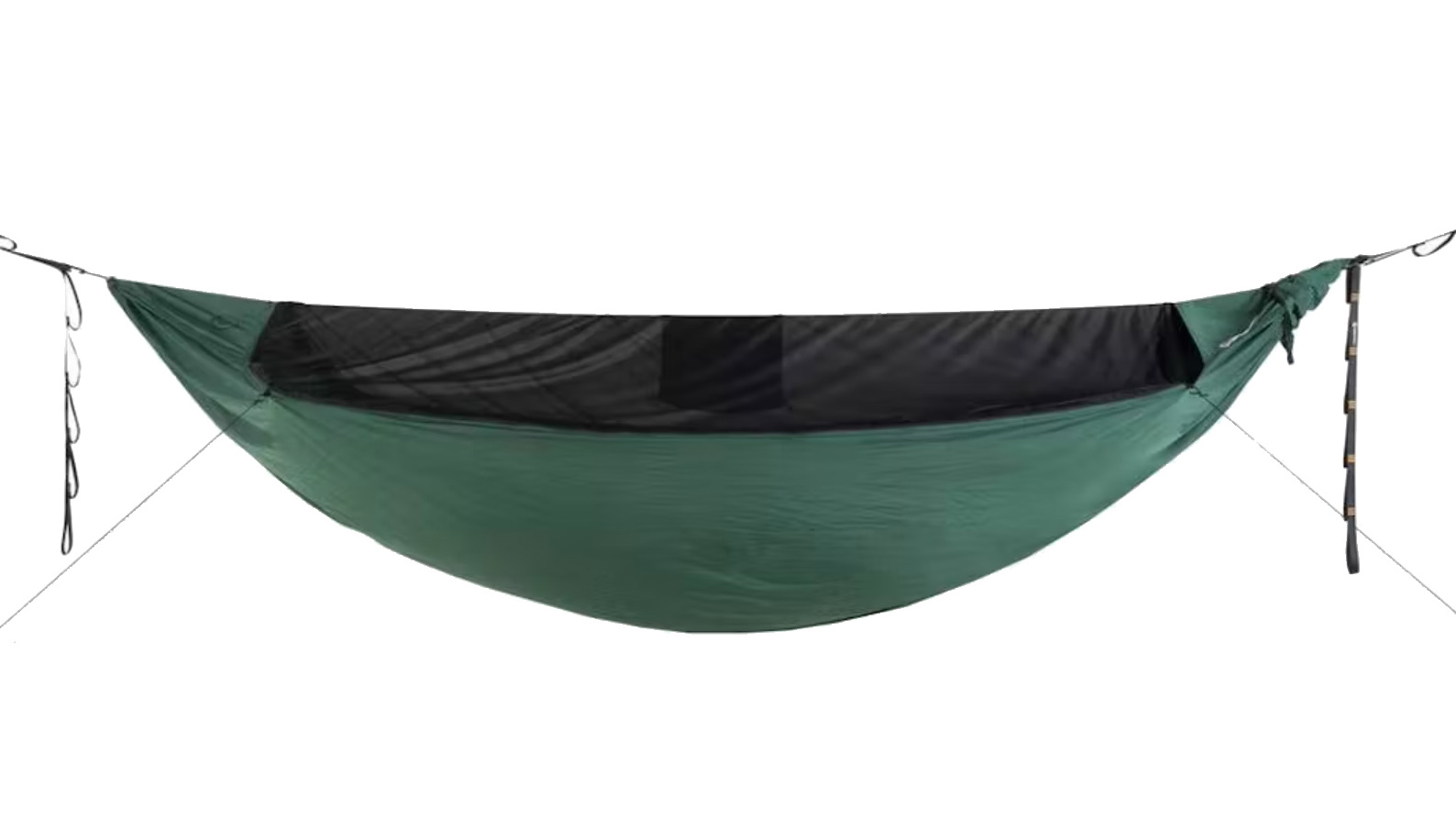
Specifications
Reasons to buy
Reasons to avoid
Bali-based Ticket to the Moon have been making handmade, socially responsible hammocks since 1996 and the Lightest Pro incorporates everything that you want out of a hammock. True to its name, this hammock tips the scales at a mere 1lb 4oz (566g) and stuffs easily into your backpack. However, it doesn’t skimp on technical features or robustness. Sturdy parachute nylon holds up to 220lbs (100kg) and added length gives you loads of room to get comfortable, even with a sleeping pad and bag. Though it’s not quite as wide as the Pro, you’ll be comfortable hanging in it all night long and save a good bit of weight and room in your pack.
An integrated ridgeline lets you adjust the hang of your hammock to keep your back as straight as you want and even has a handy little storage pouch to stash the bug net or hold gear you want close when you’re sleeping. The fabrics and bug net are both breathable so you won’t be sweating away if the mosquitos are biting, and with one test-run, this hammock is super easy to hang and climb into with double-sided, four-zip access. Don’t forget to order a suspension set with yours if you need one.
Read our full Ticket to the Moon Lightest Pro Hammock review
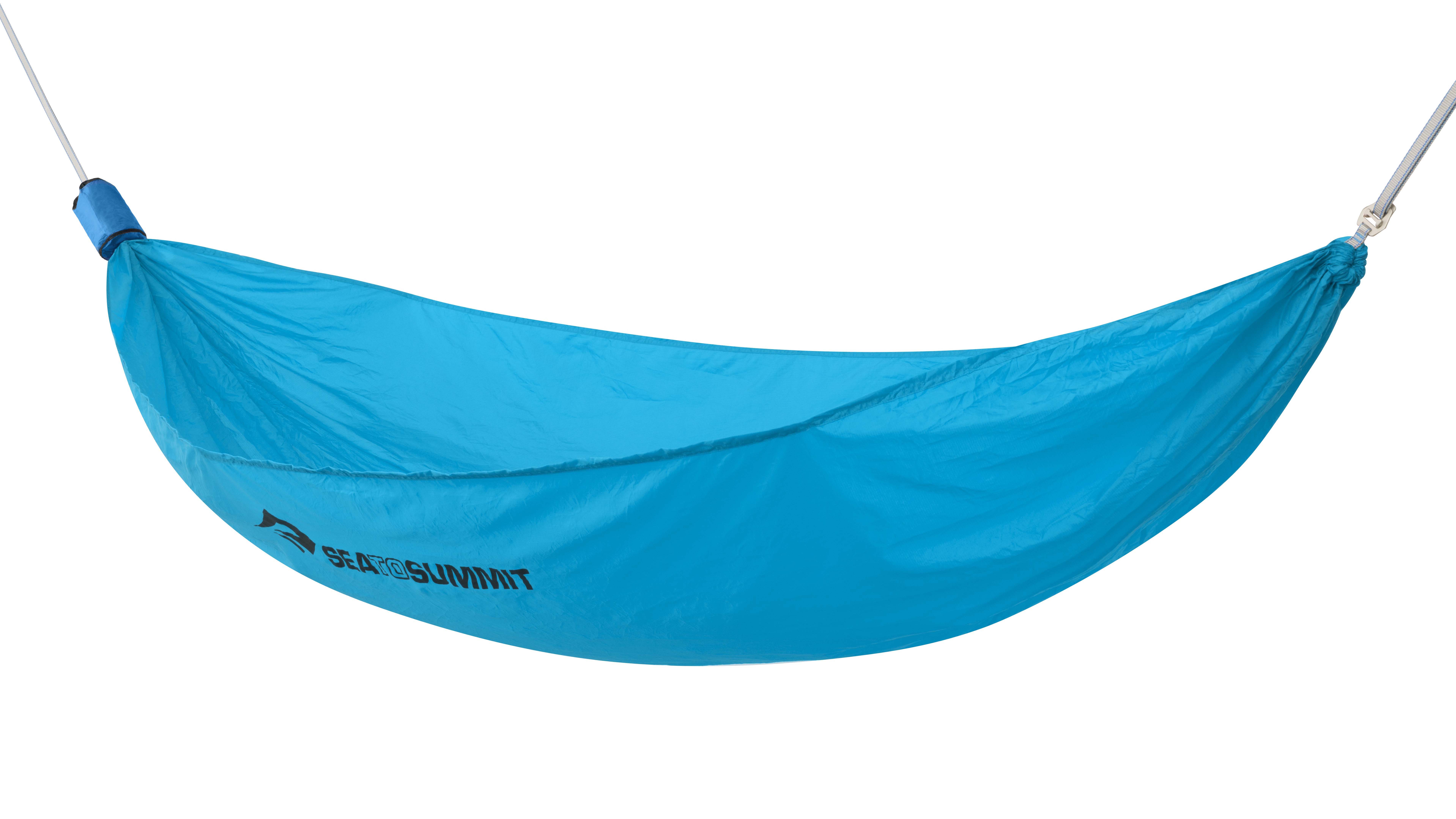
Specifications
Reasons to buy
Reasons to avoid
The Sea to Summit Pro Double Hammock is a great option for hanging out this summer. Whether you’re beach bound, foraging in the forest, hiking up hills or kicking back at the campsite, the versatility of this lightweight hammock will enhance your adventures.
The Double – the clue is in the name, you see – can hold two grown adults, with a capacity of 180kg. Ripstop nylon and high-strength, plated steel buckles provide the strength, while the 3-dimensional buckle assembly ensures stability. Backpackers will rejoice at the way the Cordura fabric stuff sack cinches down to a compressed size of 175mm, making it exceptionally portable for a hammock of this size, easily slotting into a daypack.
However, those who regularly camp out in inclement weather will need to obtain a tarp, which Sea to Summit sell as an additional accessory. There’s also a compatible bug net for fending off those pesky biting insects. In order to leave no trace, Sea to Summit also sell tree protectors separately. The Pro Double is exclusively compatible with Sea to Summit compression straps, so you won’t be able to use any others with it.
Read our full Sea to Summit Pro Double Hammock review
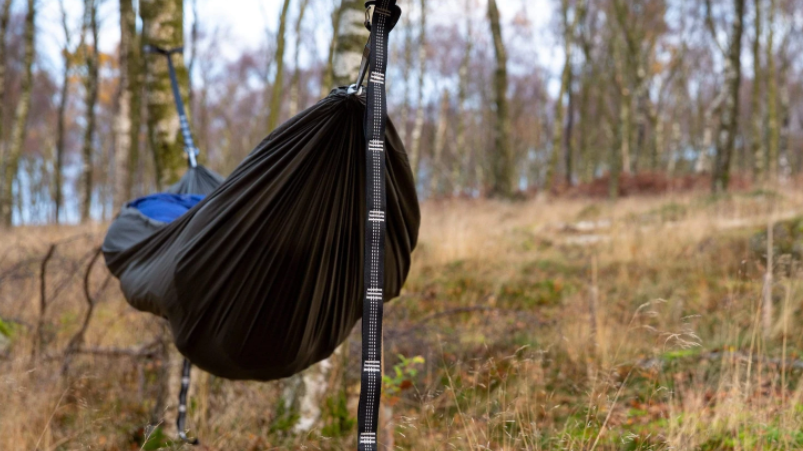
Specifications
Reasons to buy
Reasons to avoid
The best hammocks are simple. Simple is good, and this single-skin option does all that’s needed for nights out in wooded country without adding complications. The easily adjustable suspension system adds a few ounces over ropes and knots, but it is well worth it for the speed and accuracy in hanging the Alpkit Mora; it took me under four minutes to have the hammock correctly centered and hanging at the right height.
Like all single-skin hammocks, arranging a sleeping mat correctly under one takes some practice, but the dimensions of the skin are generous enough to allow for the correct diagonal sleeping position and no sense of claustrophobia. The ‘kelp’ color is what’s needed for bushcraft and low-impact, stealth camping.
Read our full Alpkit Mora Single Sleeper review
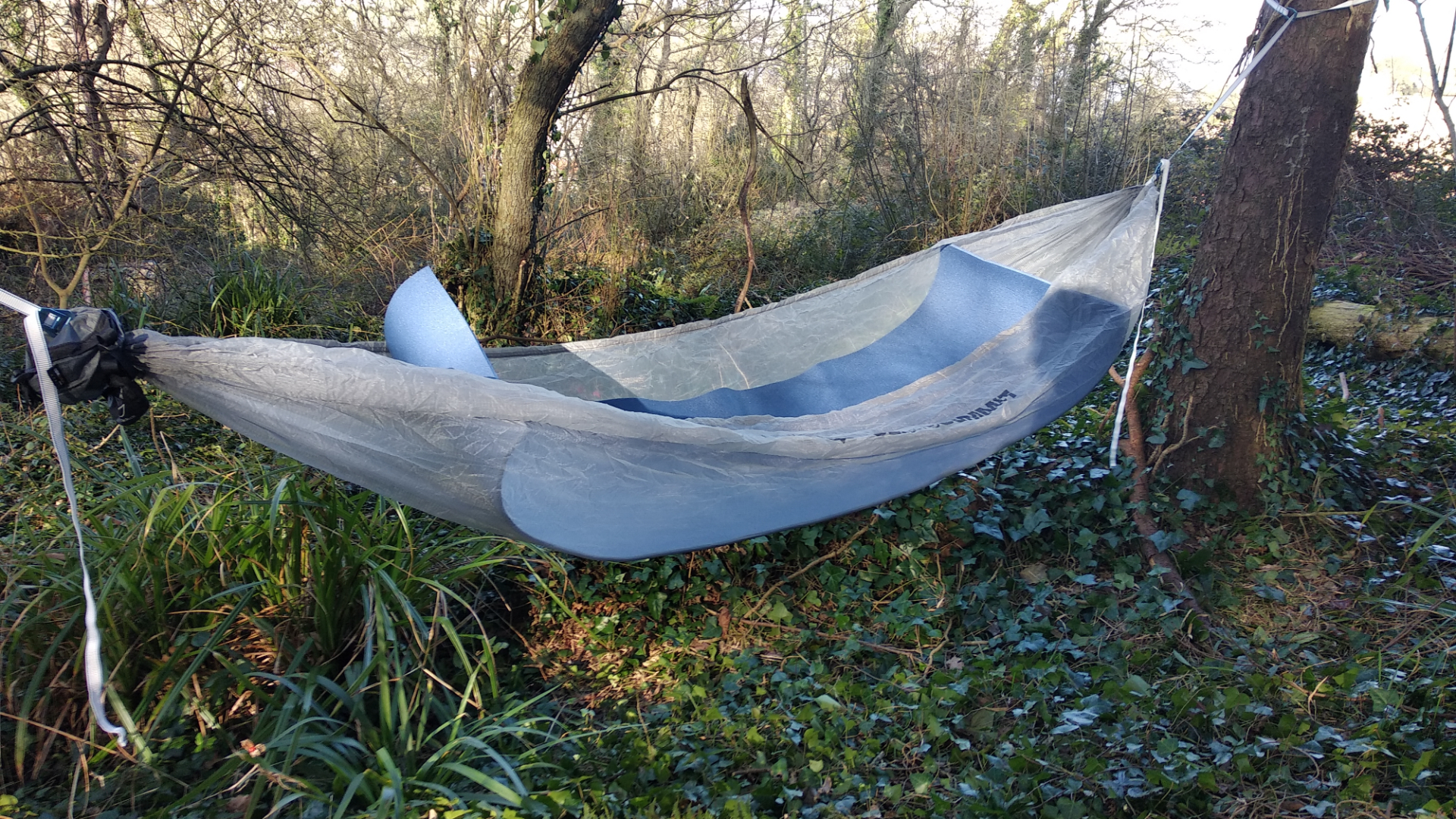
Specifications
Reasons to buy
Reasons to avoid
Clever design and high-tech materials have been used to create a fully functioning hammock that compresses down to a grapefruit-sized bundle, so it can be slipped into a pack side pocket. The suspension straps (an add-on buy; you can also use correct strength ropes) are quick to deploy whilst the slide buckles allow for precise alterations to get the centering and the height right. Sea to Summit advises against sleeping more than 18 inches above the ground, but that’s about the right height for comfortable and practical use anyway.
Despite its tiny packed size the Ultralight has the necessary length and breadth for sleeping on the diagonal comfortably. Because of its gossamer light fabric it’s not a hammock for rough and tumble swinging; I’d consider it for a super-light trip in the right conditions, or as an add-on to an existing tarp, mat and bivvy bag sleeping setup to give more versatility and provide the opportunities for hammock sleeping comfort whenever trees and circumstances allow.
Read our full Sea to Summit Ultralight Hammock review

Specifications
Reasons to buy
Reasons to avoid
For those whose experience of hammocks comes from travels in South America or Asia the Amazonas Ultra-light Silk Traveller will bring back memories. It’s colorful, packs small and has traditional cred. Rather than the skin being gathered in at each end, the hammock is hung on a web of fine strings running to eyelets which allow it to spread out wider (tip from experience: try not to tangle them when packing up). You can either use ropes to suspend the hammock or buy Amazonas’ own T-strap or adventure rope system.
The breathable parachute silk – actually nylon nowadays – is a boon in hot weather and this, allied to the tiny size, simplicity and robustness and ease of hanging, makes it an ideal piece of kit to throw into your best daypack for a siesta or lounging option on a summer’s hike. Use a closed cell mat and a light sleeping bag and a summer night under the stars becomes a possibility.
Read our full Amazonas Ultra-light Silk Traveller Techno review
Hammocks for all seasons
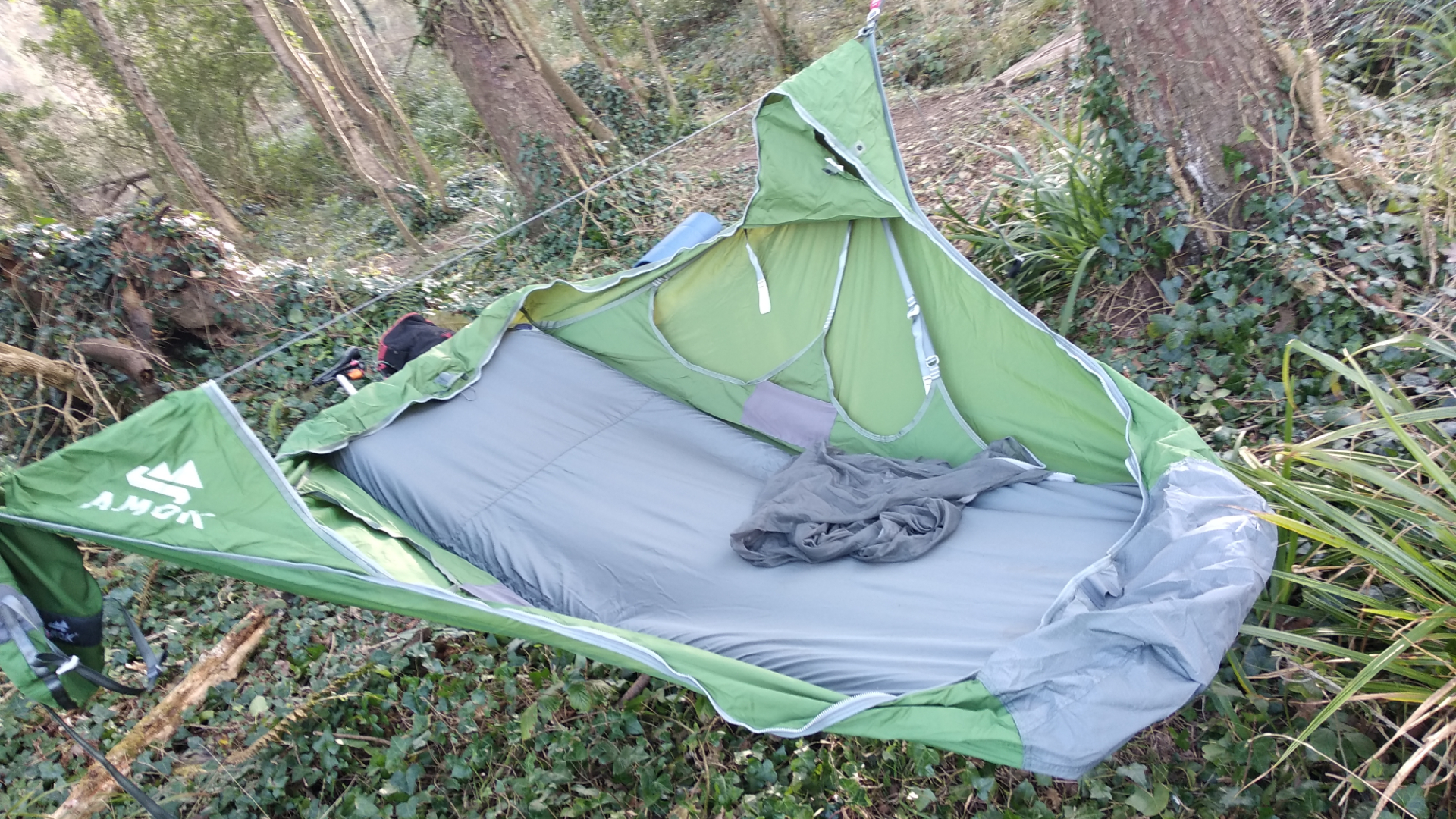
Specifications
Reasons to buy
Reasons to avoid
Rather than sleeping lengthwise between suspension points, as with other hammocks, the Amok is built around a fabric platform that hangs across its axis. It’s an innovative design that, using adjustable straps, and an integral inflatable mat, allows one to sleep flat, sit-up or pull the platform into a comfortable, supporting lounger-chair shape for evening reading or contemplating the stars. The Amok’s Norwegian bushcraft enthusiast manufacturers have drawn on several Scandinavian preoccupations for their mould-breaking design, including comfort and thwarting mosquitoes.
A ‘floor’ pocket holds an inflatable mat or other firm insulation, there are numerous pockets to hold kit and there is a full zip-round bug net over an integral ridgeline. Amok’s shaped rain fly (or another tarp big enough to cover the configuration) provides weather-proofing. For trips – especially by bike or kayak – in landscapes where trees are easy to find, the Amok functions more like a suspended tent than a hammock, and with the right accessories and skills could provide the basis for cosy winter camping. Hanging the Amok, familiarising yourself with its features and adjustments, as well as getting in and out, are definitely worth practising before your first trip. For my 5’ 11’’ body the standards dimensions were just about right, but for anyone taller choose the XL size.
Read our full Amok Draumr review
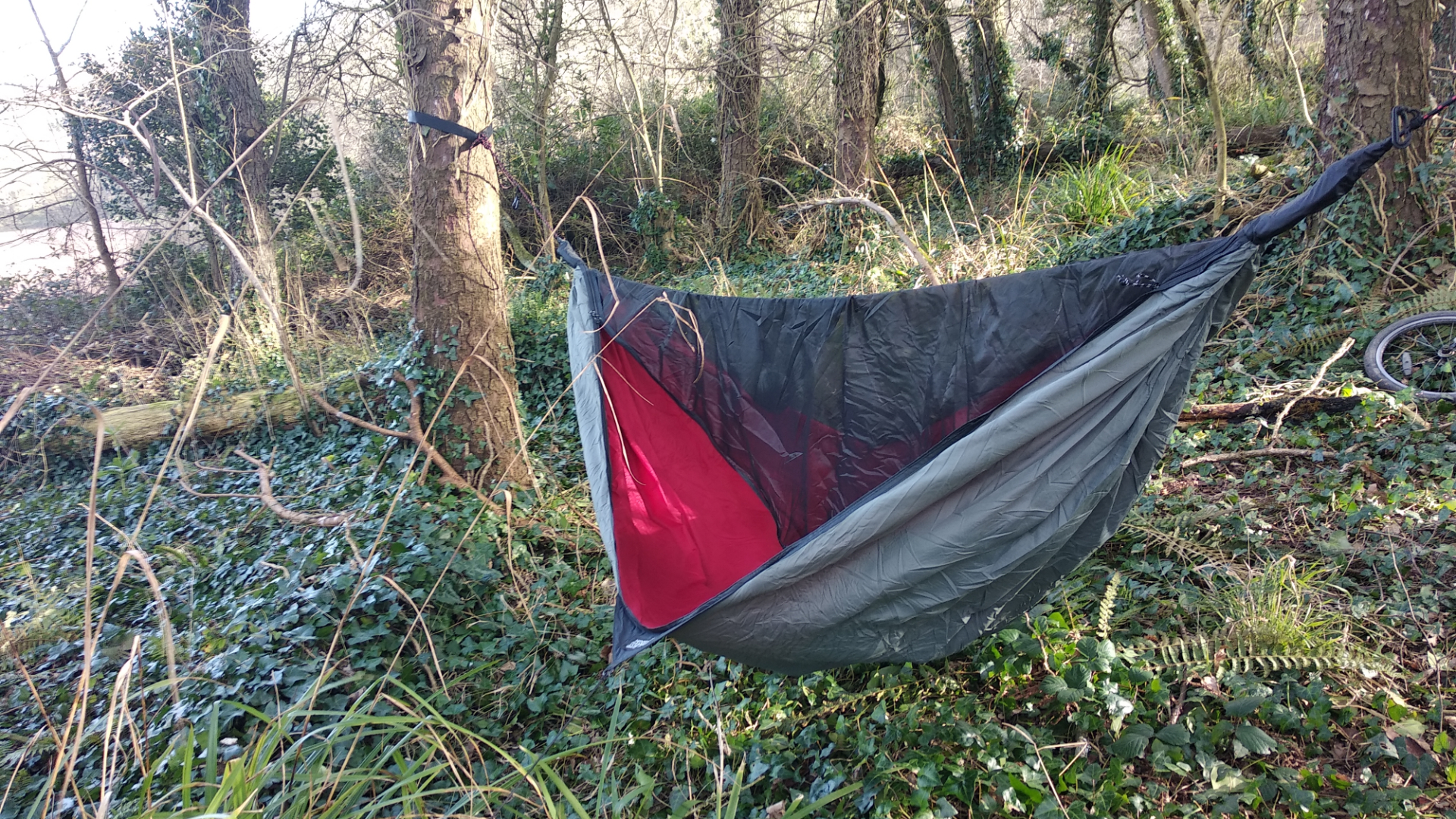
Specifications
Reasons to buy
Reasons to avoid
North America is the home of all-season hammock camping and Hennessy has 20 years of experience in coming up with designs and features for the serious hammock camper. Whilst the 4Season is still suspended in the normal way, using tree-saver straps and ropes at either end to make putting up and taking down quick and easy, its asymmetric cut gives a flatter, roomier sleeping area orientated diagonally across the axis.
Other features include a zipped mosquito net, and a full-length pocket in the skin that keeps a supplied open-cell mat under your body and which can take more layers of insulation if needed. The skin’s waterproof lower layer means that the whole hammock can be used on the ground, under a tarp, if lack of trees, or weather dictates. Ideally the hammock is paired with Hennessy’s own hexagonal-shaped rain fly but any suitably sized tarp would work; indeed the whole design encourages adaptability and improvisation to meet different situations. For cold, wet or snow sleeping the complete set up compares favourably in carry weight and size with a tent based system, but potentially provides more sleeping comfort.
Read our full Hennessy Hammock 4Season Expedition review
Insect resistant hammocks
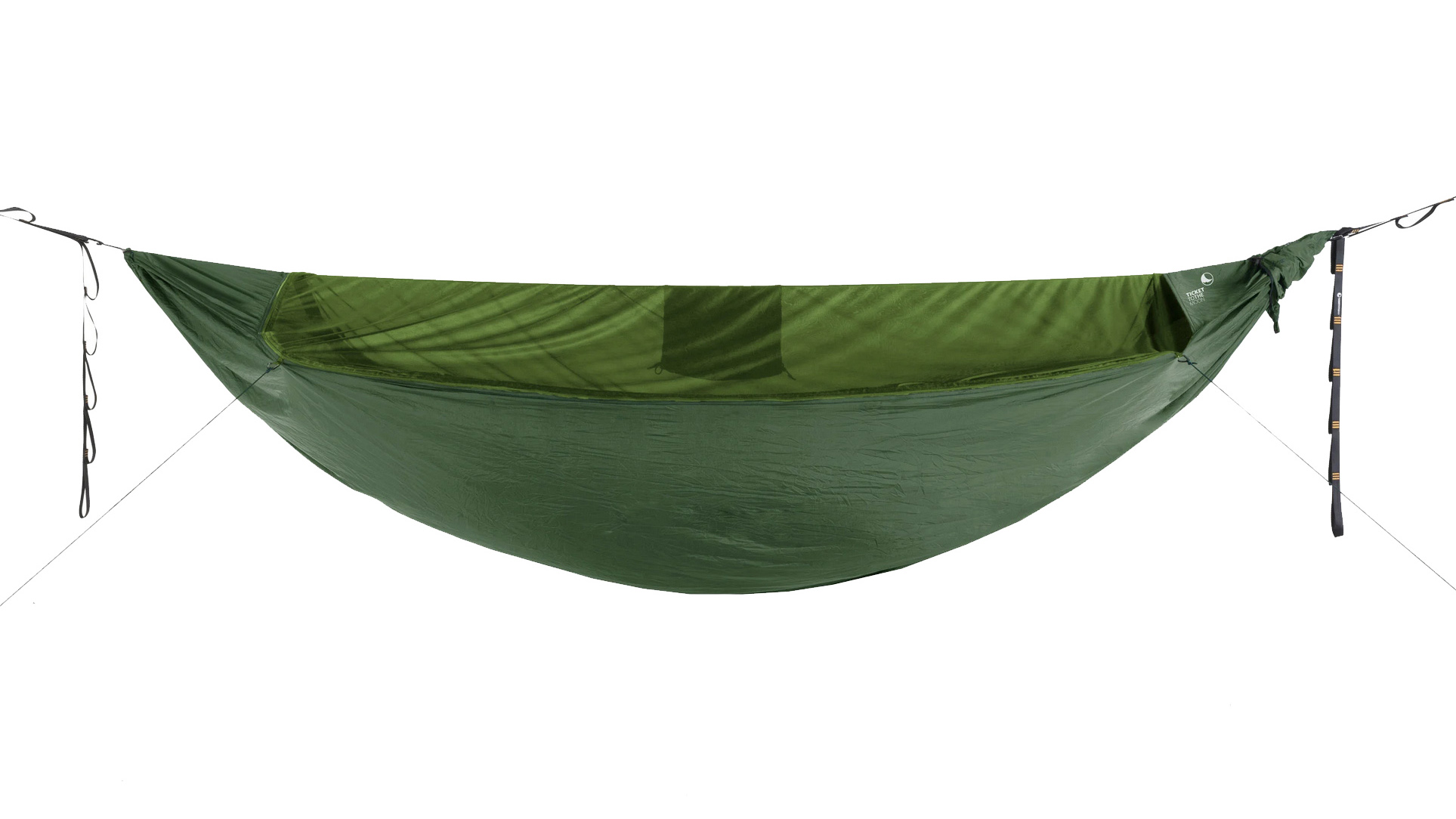
Specifications
Reasons to buy
Reasons to avoid
Bali-based Ticket to the Moon have been making camping hammocks since 1996 and the Original Pro showcases their expertise in off-ground sleep solutions for camping. The key to this hammock is in the name – it is best for people who are serious about hammock camping. Sturdy parachute nylon holds up to 150kg and a two-meter width gives you loads of room to get comfortable even with a sleeping pad and bag. The integrated ridgeline lets you adjust the hang of your hammock to keep your back as straight as you want and even has a handy little storage pouch to stash the bug net or hold gear you want close when you’re sleeping.
Though it’s great for pros, this hammock is quite quick and easy to hang for beginners too, so if you’ve never been hammock camping before and want a top quality piece of gear to get you started, this is an excellent choice. The bug net is breathable if the mosquitos are biting, and stowable when they’re not. It’s easy and stable to climb into with double-sided access. The whole thing packs down into a cute, hammock-shaped stuff sack and while it’s not the lightest or the most packable hammock on the market, the shape of the compression sack makes it easy to slide into your hiking backpack. Don’t forget to order a suspension set with yours if you need one.
Read our full Ticket to the Moon Original Pro Hammock review
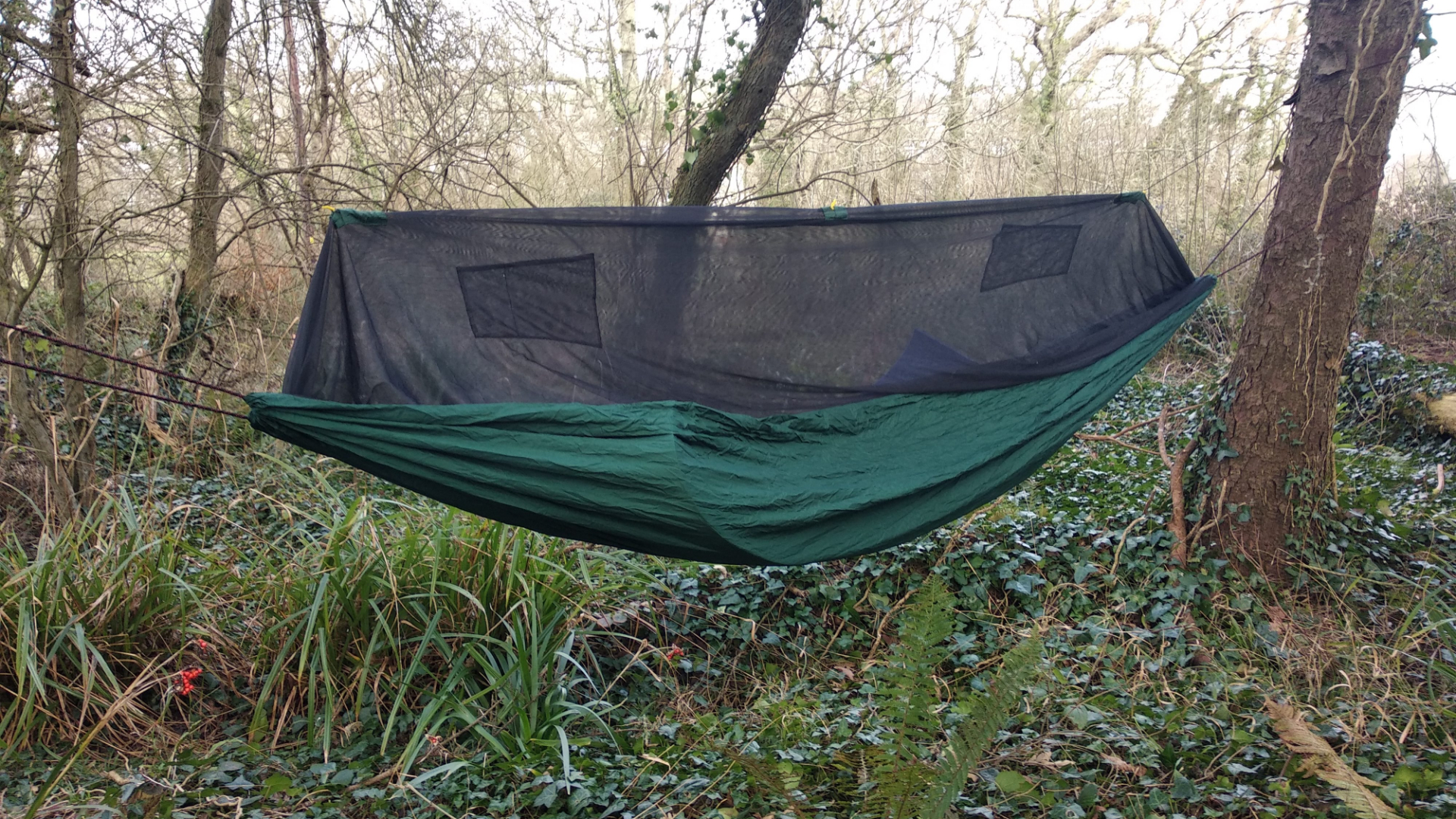
Specifications
Reasons to buy
Reasons to avoid
A practical bushcraft hammock, with a well-designed mosquito net with a mesh fine enough to keep out black fly, no-see-ums and other horrors. Insects are the bane of sleeping out, especially in the regions and seasons that can be the best hammock camping spots. The Hammock Bliss No-See-Um No More is quick to put up – though I’d use longer ropes to give more options if there weren’t a lot of trees to choose from – and the bug net is easy to deploy once you’re in the hammock. A YKK zipper completely seals the gap between the net and the opening along one long side of the hammock (you’ll need to ensure that the opening is on the side you want when you’re hanging it), while elastic guys hold the net clear.
Generous dimensions for a single hammock make it easy to get a good diagonal lying position, and also holds a mat and bedding in place better than many, meaning those with experience could comfortably use this across three seasons.
Read our full Hammock Bliss No-See-Um No More review
Hammocks for summer
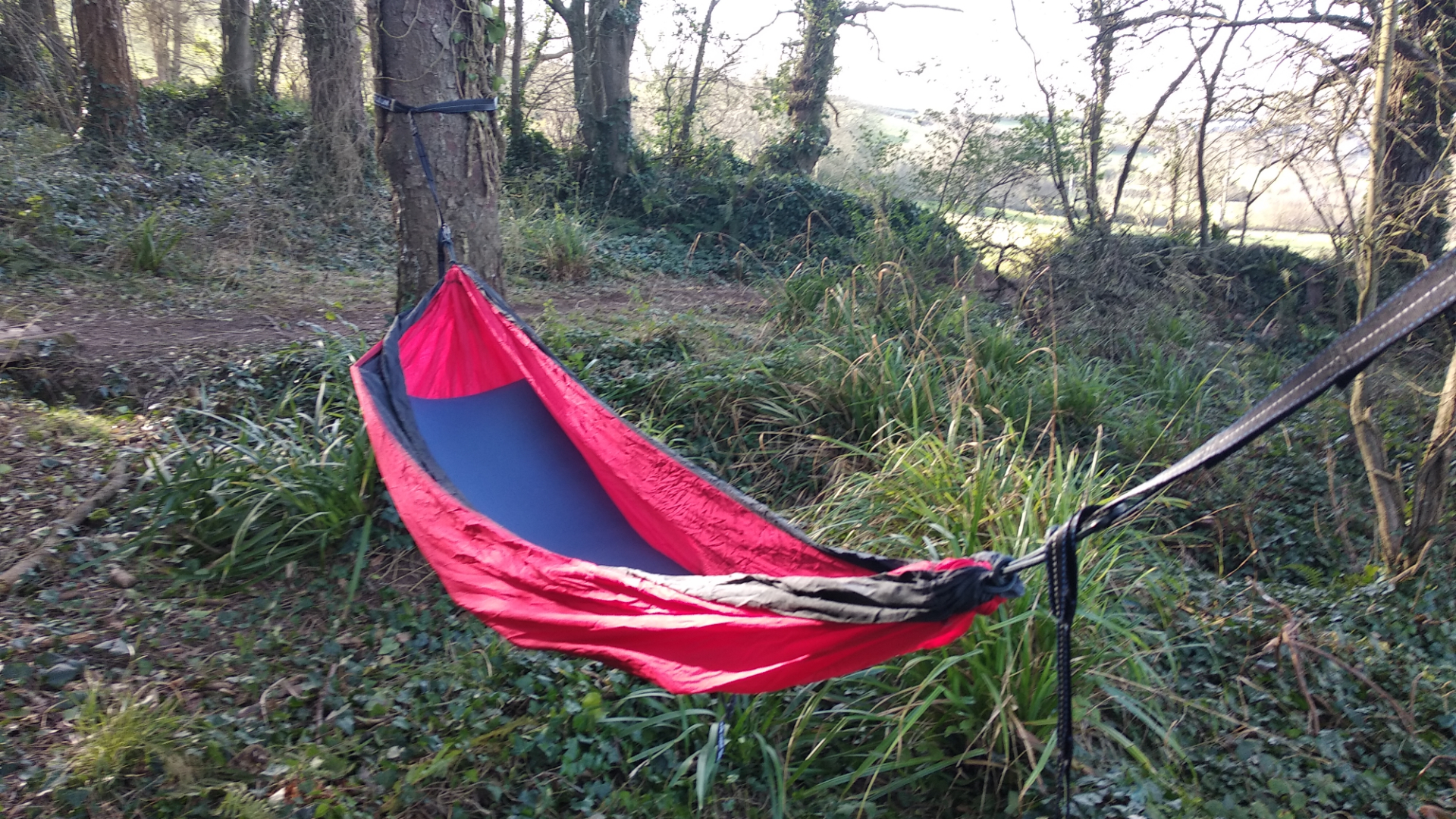
Specifications
Reasons to buy
Reasons to avoid
The ENO SingleNest’s size, simplicity, comfortable fabric and cheery colors make this hammock a versatile choice for numerous fair-weather situations. It’s a good carry as a siesta hammock on day hikes, useful for those festivals where there are trees and – beefed up with the right insulation and sleeping bags or quilts – fine for summer sleeping out if discretion isn’t important.
The recommended Atlas suspension system adds weight but makes suspension and adjustment quick and easy, but you could also use ropes and knots to clip the included end carabiners into. The taffeta fabric holds an insulation mat in place with more grip than some other more slippery skins, and is cool and comfortable without a mat making it ideal for summer weather or for hanging in the garden.
Read our full Eagles Nest Outfitters SingleNest review
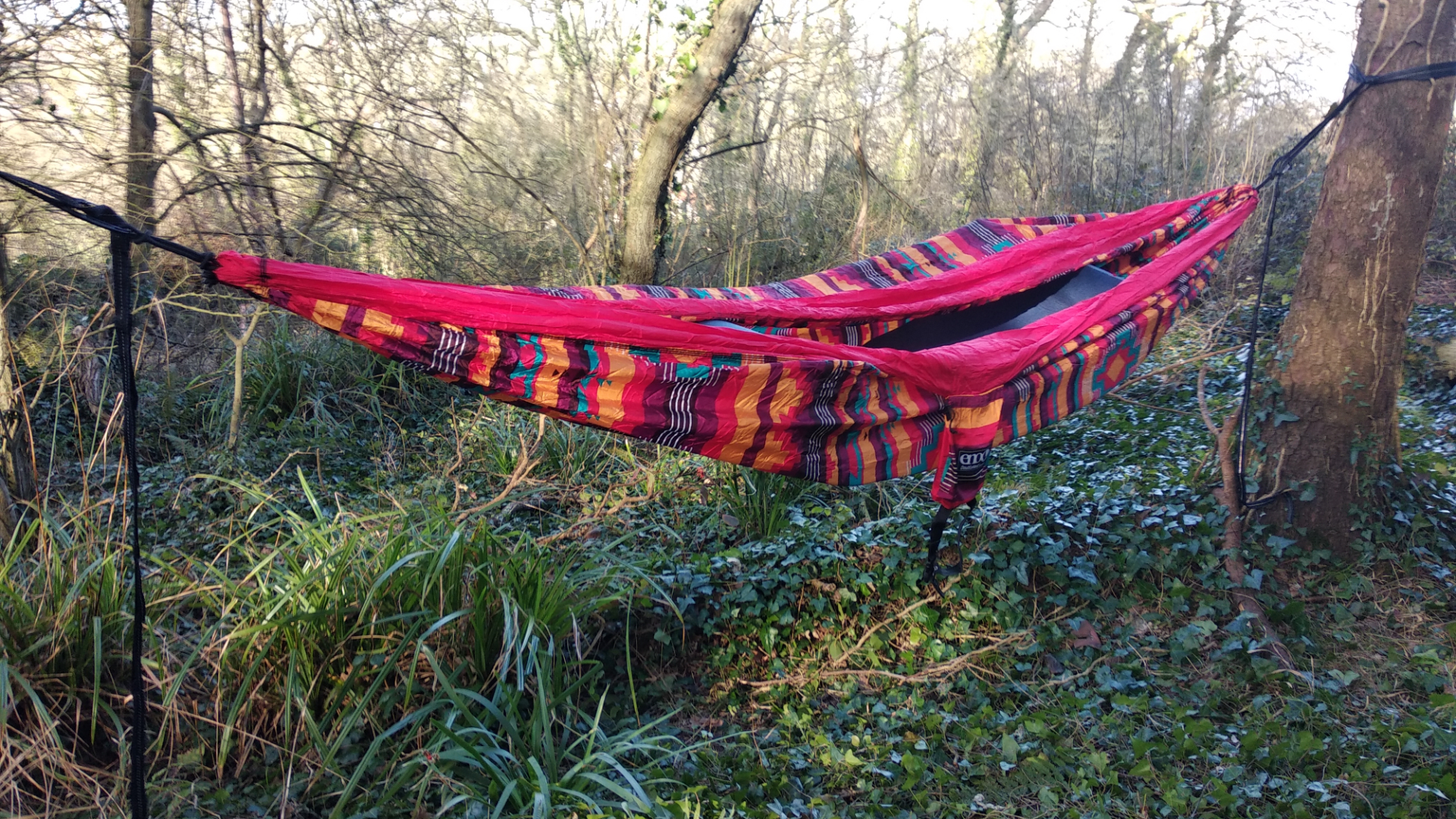
Specifications
Reasons to buy
Reasons to avoid
Two people sleeping through the night in one hammock is a romantic idea that rarely survives reality; insulation mats, quilts or sleeping bags, as well as limbs and bodies end up tangled in each other and all too close for real comfort. Nonetheless, this generously sized, and strong, double hammock provides some real value in two ways.
It’s ideal for a couple of people to lounge or take a siesta in when it’s warm enough not to need supplementary sleeping gear, making the DoubleNest ideal to carry on a long day hike or to hang in the garden or park. Less obviously, for one person there’s a real luxury in spreading oneself across a bigger skin; for a relatively small weight penalty a more generous size changes the geometry of the hammock making it even easier to get comfortable. As with the SingleNest, the taffeta fabric is comfortable and grips a mat well, though for the added weight of two people the Atlas suspension system has many advantages over ropes and knots.
Read our full Eagles Nest Outfitters DoubleNest review
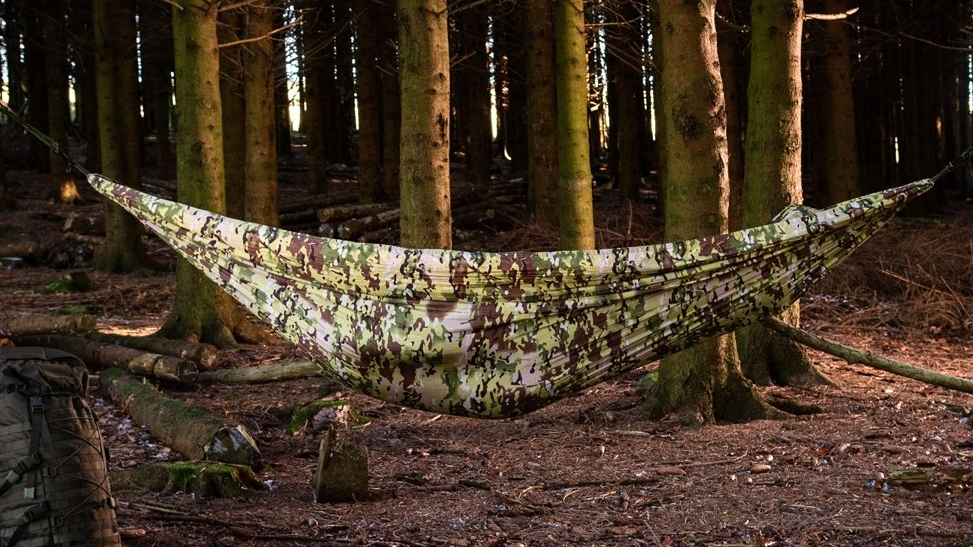
Specifications
Reasons to buy
Reasons to avoid
Snugpak have added a few refinements to what is a satisfyingly traditional design. Suspending the hammock is made easier and more accurate with ropes attached to tree-saver straps, and knotted to make ‘ladder’ loops which carabiners at the ends of the skin snap into; putting up and taking the Snugpak Tropical down took me a couple of minutes. The hammock’s length is adequate for all but the tallest of users, while its generous width makes it easier to fit a mat under one and lie out on the diagonal with one's sleeping gear over and under one.
The green color, simplicity of design, toughness and versatility make this a good choice for lightweight, multi-day bushcraft trips in landscapes where you can be confident of finding suitable trees or other supports; you’ll need a light tarp or rain fly and the lack of a bug net might test your mettle some nights but this is a practical set up for beginner and more experienced hammock campers.
Read our full Snugpak Tropical review
Best hammocks comparison table
Hammock | Price | Weight | Fabric | Accessories included |
Ticket to the Moon Lightest Pro Hammock | $146.32 / £119.98 | 566g / 1lb 4oz | Parachute Nylon 64 g/m2 | Bug net, compression sack |
Sea to Summit Pro Double Hammock | $80 (US) / £70 (UK) | 670g / 23.6oz | Ripstop Nylon | Suspension straps and CORDURA Nylon compression bag |
Alpkit Mora Single Sleeper | £40 (UK) | 515g / 18oz | 20D Nylon skin, 1000D polyester webbing straps | Storage bag |
Sea to Summit Ultralight | from £90 (UK) | (Regular) 220g / 8oz (XL) 275g / 10oz | 20D Nylon monofilament skin, Dyneema non-stretch polyester blend webbing straps | Compression strap storage bag |
Amazonas Ultra-light Silk Traveller Techno | £45 (UK) / €35 (EU) | 350g / 12.5oz | Breathable nylon parachute silk | Integral stuff sack |
Amok Draumr | $200 (US) / £190 (UK) / €220 (EU) | 1350g / 48oz | 70D ripstop nylon | Mosquito net, all suspension straps |
Hennessy Hammock 4Season Expedition | $270 (US) / £140 (UK) | 1.23kg / 2lb 12oz (plus 280g / 10oz for rainfly) | 70D high density nylon taffeta | Cantery cut rainfly, integral mosquito net, compression stuff sack, open-cell foam mat, space blanket, suspension straps |
Ticket to the Moon Original Pro Hammock | $136.79 / £112.17 | 950g / 2lbs | Parachute Nylon 64 g/m2 | Bug net, compression sack |
Hammock Bliss No-See-Um No More | $92.50 (US) / £78 (UK) / $110 (AU) | 880g / 28oz | Breathable parachute nylon | Integral bug net, integral stuff sack |
Eagles Nest Outfitters SingleNest | $50 (US) / £50 (UK) | 454g / 16oz | 70D high tenacity nylon taffeta | Integral compression stuff sack |
Eagles Nest Outfitters DoubleNest | $70 (US) / £76 (UK) | 538g / 19oz | 70D high tenacity nylon taffeta | Integral compression stuff sack |
Snugpak Tropical | £45 (UK) | 600g / 21oz | Parachute nylon | Integral stuff sack |
Choosing the best hammock for you
Not all the best hammocks are made equally, and neither should they be – different people are looking for different things in their suspendible sleeping/lounging systems. Some just want something to snooze in outdoors or as an alternative to a camping chair, while others are seeking the full sleeping out system for multi-day backpacking adventures, and there are myriad requirements in between. The best hammock for you is the one that best suits the way you’re most likely to use it most often. Following are some factors to consider when buying a hammock and some of your most frequently asked questions answered...
Nets and fabric features
You can trust Advnture
Though many of the best hammocks use the same traditional design, different features increase versatility but often add weight and cost. Mosquito nets – with mesh small enough to keep out black fly – can make the difference between a great and a miserable trip in some seasons and regions. We'd all prefer mesh protection to having to douse ourselves in insect repellent for the night.
Breathable fabrics are more comfortable in hot weather; water resistant materials are better for other climates. Stuff sacks sewn to hang from one side of the hammock skin don’t get lost, and double up as kit pockets for small items. Integrated systems – like the Hennessy and the Amok – are complex kit, which with the right skills and in the right landscape can be matched against lightweight tents for weight, weather beating and overall comfort.
Weigh up the cost
Can you put a cost on a good night’s sleep in the outdoors? Well, yes, and often it’s hammock-priced. It is certainly the cheapest sleeping solution in our camping checklist. Key to value for money is choosing the best hammock to meet your needs, and maybe your ambitions for future trips. Using any hammock will teach you the skills needed to site it safely, hang it correctly and sleep comfortably if conditions and weather are good, whilst the additional insulated sleeping pads and mats, tarps and sleeping bags needed are probably already in your camping cupboard. Some people will be happy with a basic bushcraft hammock, while others might weigh up the cost of a top of the range all-season hammock system and reckon it’s more than good value for the versatility and – above all – the comfort.
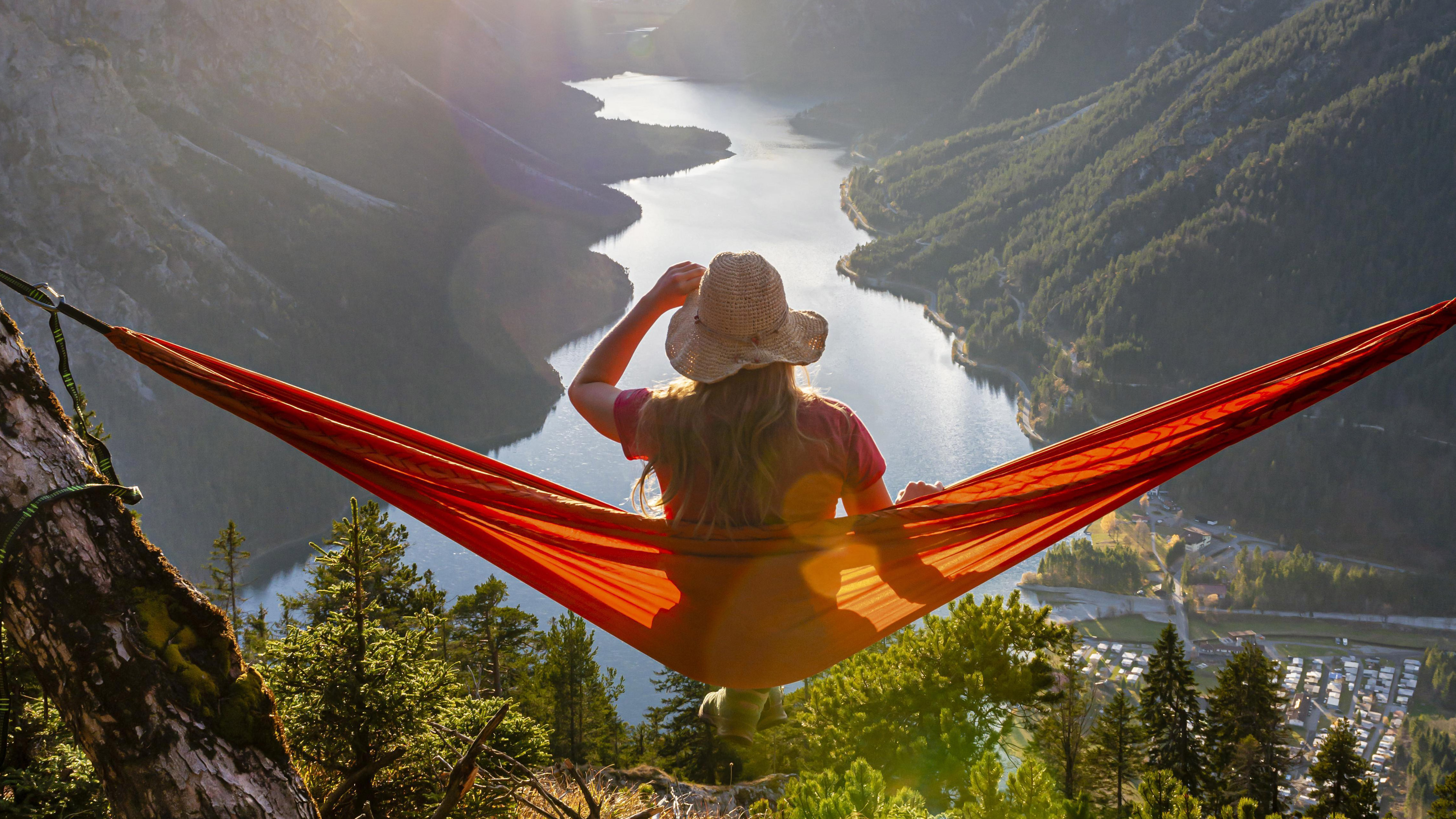
How do you hang a hammock?
One of the best things about a hammock is that you don't need to find flat ground. Even a modest slope can render a one-person tent or a bivvy completely useless. Of course, you need to find two points to suspend your hammock from, which is where the suspension system comes in.
Ropes and knots may be traditional, but easy adjust suspension straps, clips and loops make hanging a hammock with correct centering easy. Snugpak’s ladder loops in cords is a well-thought out refinement of the old school tie-up ropes method, while more sophisticated systems have tree-savers (wide webbing straps to go round trunks), carabiner to clip into loops and micro-adjust slide buckles.
A hammock skin needs to be long and wide enough to hang loosely without weight in it; this allows you to lie at a slight diagonal to the hammock’s length, which gives a flat sleeping position.
A hammock that's too small or one hung too tightly means sleeping along its length, giving you a miserable night held in a banana bend. I’m 5’11’’ (180cm) and all the best hammocks we've reviewed here were more than long enough to allow me to lie out, on an insulation mat, on the diagonal, though the more generous a hammock’s width and length the easier it was to get comfortable. Some brands, like ENO, Amok and Sea to Summit, supply XL models, which are advised if you’re above average height
Where can you hang a hammock?
Once your eye is in you’ll be amazed at how many places there are to hang a hammock; we’ve used the angle between two fence posts, belays on rocks, the insides of barns and vehicle roof racks. And if there just isn’t anywhere offering suspension possibilities, or if you’re exposed in bad weather then many of the best hammock, mat and tarp set-ups can form a makeshift bivvy on the ground.
Basic bivvy or camping skills, whether it’s choosing a location to hang your bed for the night or adjusting a tarp to deflect wind or rain, are key in hammock camping, but the simplicity of the technology rewards those skills with huge versatility. Hanging above hard, rough or sloping ground is already a good thing but a sheltered night in a wood can defeat wind and rain.
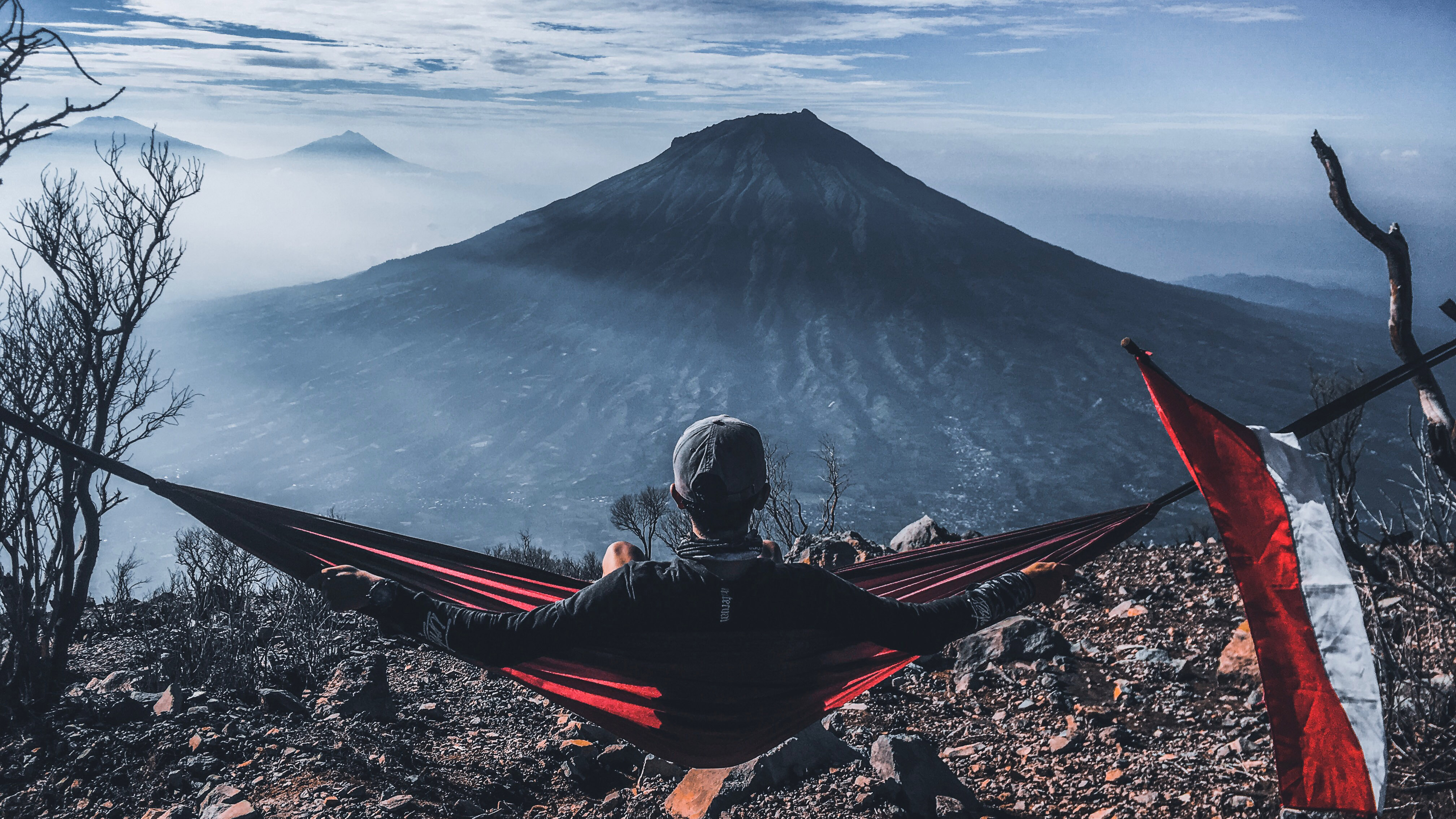
What to do with your old hammock
If you're upgrading your hammock, consider donating the old one to a thrift store, charity shop, or outdoor gear exchange to give someone else a chance to hang out and enjoy nature. If the fabric is snagged, you can repair it in a similar way to a tent (see our guide to tent repairs to get started).
If your hammock is beyond repair, you've got a nice big piece of ripstop nylon on your hands that you can use for sewing projects like making tote bags and stuff sacks. If you're not into crafts, your local recycling center may be able to take the fabric for processing with plastics. Give them a call, or drop by and ask.
Hammock FAQ
Can you hang a hammock indoors?
Hammocks can be used indoors just as easily as outdoors. To begin with in Europe, they were widely used by sailors as an alternative to sleeping on the cold, hard, wet deck of a ship. As long as you have two sturdy points to suspend it from, you're in business
Is sleeping in a hammock bad for you?
The key thing here is to make sure your hammock is the right size and that you have set it up correctly. If you've seen to this, then you're good to go. Hammocks force us to sleep on our backs, which actually reduces pressure on your spine compared to sleeping in a bed. Unlike a bed, there's also no tossing and turning in a hammock, which can lead to muscle aches in the back and neck. However, if you have pre-existing spinal issues or nerve problems, speak to your doctor before sleeping in a hammock, as it may not be a good fit for you as an individual.
Is sleeping in a hammock comfortable?
As long as you have the right size and you have set your sleeping system up correctly, then sleeping in a hammock is blessedly comfortable. This is illustrated by the fact that many hammock sleepers sleep very deeply, achieving REM sleep. This is the most restful form of sleep and leads to better mood and mental agility.
All the latest inspiration, tips and guides to help you plan your next Advnture!
After a wild childhood in west Cork, Jasper Winn began embarking on long cycles, walks, horse journeys and kayak trips across five continents – adventures he’s decanted into books, magazine articles, radio and television documentaries. Keen on low-tech but good gear, Jasper is an advocate of slow adventures by paddle, pedal, saddle, boot and sail. He has circumnavigated Ireland by kayak and cycled across the Sahara. Twice. Having ridden north-to-south across Algeria he discovered the only way to get back was to turn round and pedal north again.
